Cambridge, Massachusetts, Hgh State Clinic, Hgh Injections, Hrt Doctors
Cambridge, Massachusetts Blood Testing Facilities
 Represents a LabCorp blood testing facility
Represents a LabCorp blood testing facility Represents a Quest Diagnostics blood testing facility
Represents a Quest Diagnostics blood testing facility
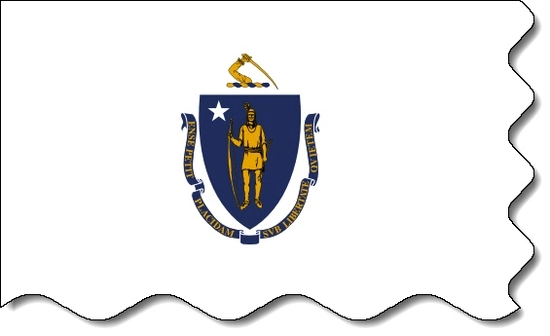
Nearby Labcorp Blood Testing facilities:
- Labcorp Center Distance: 5 m, 1400 Centre St Ste 208 2Nd Fl, Newton Center, Middlesex County, MA, 2459
- Labcorp Center Distance: 6 m, 6 Lexington St 2Nd Floor, Waltham, Middlesex County, MA, 2452
- Labcorp Center Distance: 17 m, 966 Park St Unit B7, Stoughton, Norfolk County, MA, 2072
- Labcorp Center Distance: 23 m, 200 Sutton St Ste 135, North Andover, Essex County, MA, 1845
- Labcorp Center Distance: 26 m, 380 Merrimack St Ste B2, Methuen, Essex County, MA, 1844
- Labcorp Center Distance: 29 m, 25 Pelham Rd Ste 103A, Salem, Rockingham County, NH, 3079
- Labcorp Center Distance: 31 m, 49 Range Rd Ste 101, Windham, Rockingham County, NH, 3087
- Labcorp Center Distance: 35 m, 21 Eastern Avenue Suite G2, Worcester, Worcester County, MA, 1605
- Labcorp Center Distance: 41 m, 756 Eddy St Suite 101, Providence, Providence County, RI, 2903
- Labcorp Center Distance: 43 m, 72 Cudworth Rd, Webster, Worcester County, MA, 1570
- Labcorp Center Distance: 45 m, 101 Riverway Pl, Bedford, Hillsborough County, NH, 3110
- Labcorp Center Distance: 50 m, 875 Greenland Rd Orchard Park, Portsmouth, Other, NH, 3801
- Labcorp Center Distance: 59 m, 750 Central Ave Ste E, Dover, Strafford County, NH, 3820
- Labcorp Center Distance: 61 m, 21 Clark Way, Somersworth, Strafford County, NH, 3878
- Labcorp Center Distance: 65 m, 40 Winter St Ste 200, Rochester, Strafford County, NH, 3867
- Labcorp Center Distance: 76 m, 12 Case St Ste 302, Norwich, New London County, CT, 6360
- Labcorp Center Distance: 94 m, 2284 Berlin Turnpike, Newington, Hartford County, CT, 6111
Nearby Quest Blood Testing facilities:
- Quest Center Distance: 1 m, 319 Longwood Ave, Boston, Suffolk County, MA, 02115-5728
- Quest Center Distance: 4 m, 22 Mill Street, Suite 107, Arlington, Middlesex County, MA, 02476-4738
- Quest Center Distance: 10 m, 500 Congress St Ste 1E, Quincy, Norfolk County, MA, 02169-0908
- Quest Center Distance: 14 m, 335 Morse St, 1St Floor, Norwood, Norfolk County, MA, 02062-5034
- Quest Center Distance: 15 m, 851 Main Street, S. Weymouth, Norfolk County, MA, 02190-2409
- Quest Center Distance: 16 m, 223 Chief Justice Cushing Hwy, Cohasset, Norfolk County, MA, 02025-1391
- Quest Center Distance: 20 m, 210 Quincy Ave, Brockton, Plymouth County, MA, 02302-2864
- Quest Center Distance: 21 m, 138 Haverhill St, Andover, Essex County, MA, 01810-1509
- Quest Center Distance: 22 m, 10 Commercial St, Foxboro, Norfolk County, MA, 02035-2509
- Quest Center Distance: 27 m, 62 Brown Street, Haverhill, Essex County, MA, 01830-6790
- Quest Center Distance: 28 m, 45 Stiles Rd Ste 102, Salem, Rockingham County, NH, 03079-2850
- Quest Center Distance: 32 m, 300 Main St, Nashua, Hillsborough County, NH, 03060-4635
- Quest Center Distance: 35 m, 100 Mlk, Jr. Blvd, Worcester, Worcester County, MA, 01608-1220
- Quest Center Distance: 37 m, 57 Long Pond Rd, Plymouth, Plymouth County, MA, 02360-2670
- Quest Center Distance: 39 m, 1 Randall Sq, Providence, Providence County, RI, 02904-2709
- Quest Center Distance: 44 m, 160 South River Road, Bedford, Hillsborough County, NH, 03110-5956
- Quest Center Distance: 45 m, 101 President Ave, 1St Floor, Fall River, Bristol County, MA, 02720-2652
- Quest Center Distance: 46 m, 106 Main Street, Wareham, Plymouth County, MA, 02571-2122
- Quest Center Distance: 47 m, 195 Mcgregor Street, Manchester, Hillsborough County, NH, 03102-3748
- Quest Center Distance: 50 m, 237 State Rd, North Dartmouth, Bristol County, MA, 02747-2612
- Quest Center Distance: 51 m, 200 Griffin Rd Unit 12, Portsmouth, Rockingham County, NH, 03801-7114
- Quest Center Distance: 61 m, 280 Pleasant St, Concord, Merrimack County, NH, 03301-2553
- Quest Center Distance: 64 m, 923 Main Street Route 6A, Yarmouth Port, Barnstable County, MA, 02675-5100
- Quest Center Distance: 69 m, 229 Cranberry Hwy, Orleans, Barnstable County, MA, 02653-3272
- Quest Center Distance: 70 m, 135D Storrs Rd, Mansfield Center, Tolland County, CT, 06250-1638
- Quest Center Distance: 71 m, 391 West Street, Keene, Cheshire County, NH, 03431-0000
- Quest Center Distance: 75 m, 55 Town Street, Norwich, New London County, CT, 06360-2332
- Quest Center Distance: 76 m, 118 New London Turnpike, Norwich, New London County, CT, 06360-2616
- Quest Center Distance: 79 m, 520 Hartford Turnpike, Vernon, Tolland County, CT, 06066-0000
- Quest Center Distance: 82 m, 14 Country Club Rd, Gilford, Belknap County, NH, 03249-6907
- Quest Center Distance: 83 m, 555 Main Street, Manchester, Hartford County, CT, 06040-5196
- Quest Center Distance: 85 m, 2 Concorde Way, Building 3A, Windsor Locks, Hartford County, CT, 06096-1577
- Quest Center Distance: 87 m, 721 Bank Street, New London, New London County, CT, 06320-5005
- Quest Center Distance: 89 m, 15 Chesterfield Road, East Lyme, New London County, CT, 06333-1730
- Quest Center Distance: 91 m, 465 Silas Deane Highway, Wethersfield, Hartford County, CT, 06109-2134
- Quest Center Distance: 94 m, 381 Hopmeadow Street, Simsbury, Hartford County, CT, 06089-9692
- Quest Center Distance: 96 m, 400 Saybrook Rd, Middletown, Middlesex County, CT, 06457-4731
- Quest Center Distance: 98 m, 665 Boston Post Road, Old Saybrook, Middlesex County, CT, 06475-1521
Massachusetts Hormone Replacement Therapy Solutions
The Conscious Evolution Institute is Massachusetts' best source for twenty-first century Hormone Optimization and Restoration. We serve every corner of Massachusetts, and we can even meet you at your home or business in order to perform the evaluation necessary to make an informed diagnosis on your behalf.
With our assistance, we can help you mitigate or overcome the pitfalls of hormone imbalance, improving your health and wellness and increasing the odds that you live a longer and happier life.
Massachusetts HGH Therapy
One of the premier services that we offer at the Conscious Evolution Institute is Bio-Identical Human Growth Hormone Replacement Therapy. HGH is one of the most important and vital hormones that the body produces when it comes to maintaining optimal health and function.
Growth Hormone controls cellular metabolism, enhancing the efficiency of cellular processes throughout the body. As we grow older, our HGH Levels decline and our bodies slowly lose the capacity to sustain the rehabilitative processes which keep us functioning at peak capacity, which leads to symptoms of premature aging and a litany of symptoms that diminish our physical and psychological well-being.
HGH Injections are designed to restore HGH concentrations to more youthful levels, keeping the body functioning more efficiently, and these services are available to men and women over the age of thirty with clinically diagnosed HGH Deficiency.
Massachusetts Sermorelin Injections
If you're interested in what HGH Injections can do for you, but want to maximize the value of your dollar, Sermorelin Acetate Therapy is a slightly cheaper form of therapy which provides similar benefits as Human Growth Hormone Replacement Therapy. Recombinant Sermorelin Therapy restores HGH Levels in the body by supplementing the production of Growth Hormone-Releasing Hormone by the Hypothalamus. Give us a call and ask us about which form of treatment may be best for you!
Massachusetts Testosterone Replacement Therapy
Erectile Dysfunction can be one of the most embarrassing medical conditions that a man has to deal with, but did you know that ED can actually be a symptom of more severe, underlying health issues? Low-T not only impacts sexual health, but it can severely diminish your health and vitality as well.
Symptoms of Age-Related Testosterone Deficiency include increased weight gain, loss of muscle mass, anxiety, and atherosclerosis, and if you allow these symptoms to persist, you could be shaving years off your own life. Bio-Identical Testosterone HRT can restore optimal Testosterone Levels and help enhance your health and quality of life.
Massachusetts HCG Injections for Weight Loss
The Conscious Evolution Institute also offers weight loss solutions, most notably the HCG Diet. The HCG Diet is a combination of Recombinant Hormone Injections and Caloric Restriction which has been clinically shown to rapidly encourage weight loss while softening the side-effects of dieting which make diets so often fail.
With HCG Diets, you can lose 5-7 pounds per week without experiencing any significant road bumps along the way. HCG reduces sensations of hunger and optimizes fat burning, helping you burn calories from the most troublesome areas of the body. With a simple call to our clinic, we can help melt the pounds away!
Major Cities in Massachusetts
Boston
Boston, Massachusetts is the largest city in the state of Massachusetts, as well as the largest city in all of New England. Boston is famous for being one of the most highly educated major cities in the United States, and is home to a large number of Universities, including Northeastern University, Boston University, and Boston College.
Boston has a number of prestigious professional sports teams, including the Boston Red Socks, the Boston Celtics, and the New England Patriots. The most famous athletic event held annually in Boston is the Boston Marathon, where thousands from all over the world run each and every year.
Worchester
Worchester, Massachusetts is located in the central portion of the state, in Worchester County, and is the second largest city in the state. One interesting piece of trivia about the city is that it has a number of Victorian mills. Worchester is often referred to by the nickname, The Heart of the Commonwealth. The symbol of the city is a heart.
Worchester has one of the best medical schools in the United States, The University of Massachusetts Medical School. The largest employer in the city is UMass Memorial Health Care, followed by the medical school, itself.
Springfield
Springfield is located in the southwestern portion of the state of Massachusetts, and is the third largest city by population, and the second largest metropolitan area. Springfield is one of New England's oldest cities, founded in 1636.
The city is often referred to as The City of Homes because of its numerous examples of Victorian Homes. Springfield is also known as the Hoop City, because it was the city where the sport of basketball was invented. The city is located in the heart of the Knowledge Corridor, a region with the highest concentration of liberal arts colleges in the United States.
Lowell
Lowell, Massachusetts is located in the northeastern corner of Massachusetts and is the fourth most populated city in the state. Lowell was first settled in 1653, and was historically one of the most important industrial cities in New England. Lowell is located along the meeting point of the Concord and Merrimack Rivers. Because of its historical importance as an industry town, Lowell has a number of protected landmarks, including the American Textile History Museum, the Boott Cotton Mills Museum, and the New England Quilt Museum.
Cambridge
Cambridge is the fifth most highly populated city in the state of Massachusetts, but arguably the most iconic city in the state after Boston. Cambridge is home to two of the most prestigious schools in the United States, as well as the world: The Massachusetts Institute of Technology and Harvard University.
The Cambridge economy revolves primarily around education and fields that feed off of the presence of education. There are a number of biomedical and pharmaceutical companies in the area, including Pfizer, Genzyme, and Vertex Pharmaceuticals.
All About Cambridge, Massachusetts Geographic Area
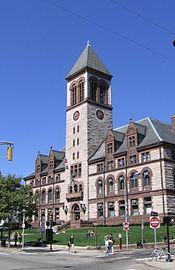
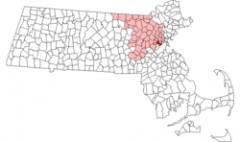
Cambridge is a city in Middlesex County, Massachusetts, United States, in the Greater Boston area. It was named in honor of the University of Cambridge in England, an important center of the Puritan theology embraced by the town's founders. Cambridge is home to two of the world's most prominent universities, Harvard University and the Massachusetts Institute of Technology. According to the 2010 United States Census, the city's population was 105,162. It is the fifth most populous city in the state, behind Boston, Worcester, Springfield, and Lowell. Cambridge is one of the two county seats of Middlesex County (Lowell is the other).
A resident of Cambridge is known as a Cantabrigian.
The site for what would become Cambridge was chosen in December 1630, because it was located safely upriver from Boston Harbor, which made it easily defensible from attacks by enemy ships. Also, the water from the local spring was so good that the local Native Americans believed it had medicinal properties. The first houses were built in the spring of 1631. The settlement was initially referred to as "the newe towne". Official Massachusetts records show the name capitalized as Newe Towne by 1632. Located at the first convenient Charles River crossing west of Boston, Newe Towne was one of a number of towns (including Boston, Dorchester, Watertown, and Weymouth) founded by the 700 original Puritan colonists of the Massachusetts Bay Colony under governor John Winthrop. The original village site is in the heart of today's Harvard Square. The marketplace where farmers brought in crops from surrounding towns to sell survives today as the small park at the corner of John F. Kennedy (J.F.K.) and Winthrop Streets, then at the edge of a salt marsh, since filled. The town included a much larger area than the present city, with various outlying parts becoming independent towns over the years: Newton (originally Cambridge Village, then Newtown) in 1688, Lexington (Cambridge Farms) in 1712, and both West Cambridge (originally Menotomy) and Brighton (Little Cambridge) in 1807. Part of West Cambridge joined the new town of Belmont in 1859, and the rest of West Cambridge was renamed Arlington in 1867; Brighton was annexed by Boston in 1874. In the late 19th century, various schemes for annexing Cambridge itself to the City of Boston were pursued and rejected.
In 1636, Harvard College was founded by the colony to train ministers and the new town was chosen for its site by Thomas Dudley. By 1638, the name "Newe Towne" had "compacted by usage into 'Newtowne'." In May 1638 the name was changed to Cambridge in honor of the university in Cambridge, England. The first president (Henry Dunster), the first benefactor (John Harvard), and the first schoolmaster (Nathaniel Eaton) of Harvard were all Cambridge University alumni, as was the then ruling (and first) governor of the Massachusetts Bay Colony, John Winthrop. In 1629, Winthrop had led the signing of the founding document of the city of Boston, which was known as the Cambridge Agreement, after the university. It was Governor Thomas Dudley who, in 1650, signed the charter creating the corporation which still governs Harvard College.
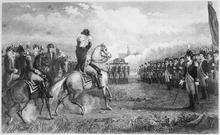
Cambridge grew slowly as an agricultural village eight miles (13 km) by road from Boston, the capital of the colony. By the American Revolution, most residents lived near the Common and Harvard College, with farms and estates comprising most of the town. Most of the inhabitants were descendants of the original Puritan colonists, but there was also a small elite of Anglican "worthies" who were not involved in village life, who made their livings from estates, investments, and trade, and lived in mansions along "the Road to Watertown" (today's Brattle Street, still known as Tory Row). In 1775, George Washington came up from Virginia to take command of fledgling volunteer American soldiers camped on the Cambridge Common aetoday called the birthplace of the U.S. Army. (The name of today's nearby Sheraton Commander Hotel refers to that event.) Most of the Tory estates were confiscated after the Revolution. On January 24, 1776, Henry Knox arrived with artillery captured from Fort Ticonderoga, which enabled Washington to drive the British army out of Boston.
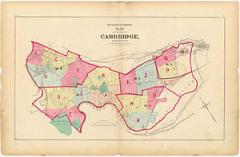
Between 1790 and 1840, Cambridge began to grow rapidly, with the construction of the West Boston Bridge in 1792, that connected Cambridge directly to Boston, making it no longer necessary to travel eight miles (13 km) through the Boston Neck, Roxbury, and Brookline to cross the Charles River. A second bridge, the Canal Bridge, opened in 1809 alongside the new Middlesex Canal. The new bridges and roads made what were formerly estates and marshland into prime industrial and residential districts.
In the mid-19th century, Cambridge was the center of a literary revolution when it gave the country a new identity through poetry and literature. Cambridge was home to the famous Fireside Poets aeso called because their poems would often be read aloud by families in front of their evening fires. In their day, the Fireside Poets aeHenry Wadsworth Longfellow, James Russell Lowell, and Oliver Wendell Holmes aewere as popular and influential as rock stars are today.
Soon after, turnpikes were built: the Cambridge and Concord Turnpike (today's Broadway and Concord Ave.), the Middlesex Turnpike (Hampshire St. and Massachusetts Ave. northwest of Porter Square), and what are today's Cambridge, Main, and Harvard Streets were roads to connect various areas of Cambridge to the bridges. In addition, railroads crisscrossed the town during the same era, leading to the development of Porter Square as well as the creation of neighboring town Somerville from the formerly rural parts of Charlestown.
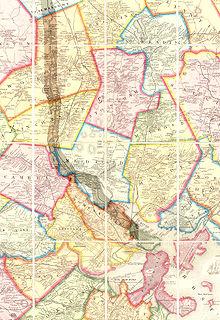
Cambridge was incorporated as a city in 1846. This was despite noticeable tensions between East Cambridge, Cambridgeport, and Old Cambridge that stemmed from differences in each area's culture, sources of income, and the national origins of the residents. The city's commercial center began to shift from Harvard Square to Central Square, which became the downtown of the city around this time. Between 1850 and 1900, Cambridge took on much of its present character aestreetcar suburban development along the turnpikes, with working-class and industrial neighborhoods focused on East Cambridge, comfortable middle-class housing being built on old estates in Cambridgeport and Mid-Cambridge, and upper-class enclaves near Harvard University and on the minor hills of the city. The coming of the railroad to North Cambridge and Northwest Cambridge then led to three major changes in the city: the development of massive brickyards and brickworks between Massachusetts Ave., Concord Ave. and Alewife Brook; the ice-cutting industry launched by Frederic Tudor on Fresh Pond; and the carving up of the last estates into residential subdivisions to provide housing to the thousands of immigrants that arrived to work in the new industries.
For many years, the city's largest employer was the New England Glass Company, founded in 1818. By the middle of the 19th century it was the largest and most modern glassworks in the world. In 1888, all production was moved, by Edward Drummond Libbey, to Toledo, Ohio, where it continues today under the name Owens Illinois. Flint glassware with heavy lead content, produced by that company, is prized by antique glass collectors. There is none on public display in Cambridge, but there is a large collection in the Toledo Museum of Art.
Among the largest businesses located in Cambridge was the firm of Carter's Ink Company, whose neon sign long adorned the Charles River and which was for many years the largest manufacturer of ink in the world.
By 1920, Cambridge was one of the main industrial cities of New England, with nearly 120,000 residents. As industry in New England began to decline during the Great Depression and after World War II, Cambridge lost much of its industrial base. It also began the transition to being an intellectual, rather than an industrial, center. Harvard University had always been important in the city (both as a landowner and as an institution), but it began to play a more dominant role in the city's life and culture. Also, the move of the Massachusetts Institute of Technology from Boston in 1916 ensured Cambridge's status as an intellectual center of the United States.
After the 1950s, the city's population began to decline slowly, as families tended to be replaced by single people and young couples. The 1980s brought a wave of high-technology startups, creating software such as Visicalc and Lotus 1-2-3, and advanced computers, but many of these companies fell into decline with the fall of the minicomputer and DOS-based systems. However, the city continues to be home to many startups as well as a thriving biotech industry. By the end of the 20th century, Cambridge had one of the most expensive housing markets in the Northeastern United States.
While maintaining much diversity in class, race, and age, it became harder and harder for those who grew up in the city to be able to afford to stay. The end of rent control in 1994 prompted many Cambridge renters to move to housing that was more affordable, in Somerville and other communities. In 2005, a reassessment of residential property values resulted in a disproportionate number of houses owned by non-affluent people jumping in value relative to other houses, with hundreds having their property tax increased by over 100%; this forced many homeowners in Cambridge to move elsewhere.
As of 2012, Cambridge's mix of amenities and proximity to Boston has kept housing prices relatively stable.
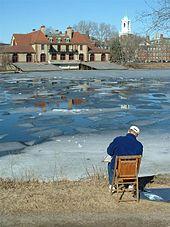
According to the United States Census Bureau, Cambridge has a total area of 7.1 square miles (18 km2), of which 6.4 square miles (17 km2) of it is land and 0.7 square miles (1.8 km2) of it (9.82%) is water.
Cambridge is located in eastern Massachusetts, bordered by:
The border between Cambridge and the neighboring city of Somerville passes through densely populated neighborhoods which are connected by the MBTA Red Line. Some of the main squares, Inman, Porter, and to a lesser extent, Harvard, are very close to the city line, as are Somerville's Union and Davis Squares.
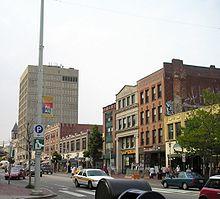
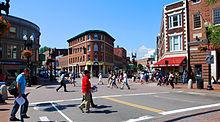
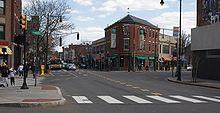
Cambridge has been called the "City of Squares" by some, as most of its commercial districts are major street intersections known as squares. Each of the squares acts as a neighborhood center. These include:
The residential neighborhoods (map) in Cambridge border, but are not defined by the squares. These include:
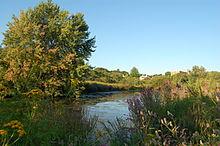
Consisting largely of densely built residential space, Cambridge lacks significant tracts of public parkland. This is partly compensated for, however, by the presence of easily accessible open space on the university campuses, including Harvard Yard and MIT's Great Lawn, as well as the considerable open space of Mount Auburn Cemetery. At the western edge of Cambridge, the cemetery is well known as the first garden cemetery, for its distinguished inhabitants, for its superb landscaping (the oldest planned landscape in the country), and as a first-rate arboretum. Although known as a Cambridge landmark, much of the cemetery lies within the bounds of Watertown. It is also a significant Important Bird Area (IBA) in the Greater Boston area.
Public parkland includes the esplanade along the Charles River, which mirrors its Boston counterpart, Cambridge Common, a busy and historic public park immediately adjacent to the Harvard campus, and the Alewife Brook Reservation and Fresh Pond in the western part of the city.
As of the census of 2010, there were 105,162 people, 44,032 households, and 17,420 families residing in the city. The population density was 16,422.08 people per square mile (6,341.98/km ²), making Cambridge the fifth most densely populated city in the US and the second most densely populated city in Massachusetts behind neighboring Somerville. There were 47,291 housing units at an average density of 7,354.7 per square mile (2,840.3/km ²). The racial makeup of the city was 66.60% White, 11.70% Black or African American, 0.20% Native American, 15.10% Asian, 0.01% Pacific Islander, 2.10% from other races, and 4.30% from two or more races. 7.60% of the population were Hispanic or Latino of any race. Non-Hispanic Whites were 62.1% of the population in 2010, down from 89.7% in 1970. This rather closely parallels the average racial demographics of the United States as a whole, although Cambridge has significantly more Asians than the average, and fewer Hispanics and Caucasians. 11.0% were of Irish, 7.2% English, 6.9% Italian, 5.5% West Indian and 5.3% German ancestry according to Census 2000. 69.4% spoke English, 6.9% Spanish, 3.2% Chinese or Mandarin, 3.0% Portuguese, 2.9% French Creole, 2.3% French, 1.5% Korean, and 1.0% Italian as their first language.
There were 44,032 households out of which 16.9% had children under the age of 18 living with them, 28.9% were married couples living together, 8.4% had a female householder with no husband present, and 60.4% were non-families. 40.7% of all households were made up of individuals and 9.6% had someone living alone who was 65 years of age or older. The average household size was 2.00 and the average family size was 2.76.
In the city the population was spread out with 13.3% under the age of 18, 21.2% from 18 to 24, 38.6% from 25 to 44, 17.8% from 45 to 64, and 9.2% who were 65 years of age or older. The median age was 30.5 years. For every 100 females, there were 96.1 males. For every 100 females age 18 and over, there were 94.7 males.
The median income for a household in the city was $47,979, and the median income for a family was $59,423 (these figures had risen to $58,457 and $79,533 respectively as of a 2007 estimate[update]). Males had a median income of $43,825 versus $38,489 for females. The per capita income for the city was $31,156. About 8.7% of families and 12.9% of the population were below the poverty line, including 15.1% of those under age 18 and 12.9% of those age 65 or over.
Cambridge was ranked as one of the most liberal cities in America. Locals living in and near the city jokingly refer to it as "The People's Republic of Cambridge." For 2012, the residential property tax rate in Cambridge is $8.48 per $1,000. Cambridge enjoys the highest possible bond credit rating, AAA, with all three Wall Street rating agencies.
Cambridge is noted for its diverse population, both racially and economically. Residents, known as Cantabrigians, range from affluent MIT and Harvard professors to immigrants. The first legal applications in America for same-sex marriage licenses were issued at Cambridge's City Hall.
Cambridge is also the birthplace of Thai king Bhumibol Adulyadej (Rama IX), who is the world's longest reigning monarch at age 82 (2010), as well as the longest reigning monarch in Thai history. He is also the first king of a foreign country to be born in the United States.
Cambridge is part of Massachusetts's 8th congressional district, represented by Democrat Mike Capuano, elected in 1998. The state's senior member of the United States Senate is Democrat John Kerry, elected in 1984. The state's junior member is Republican Scott Brown, elected in 2010 to fill the vacancy caused by the death of long-time Democratic Senator Ted Kennedy. The Governor of Massachusetts is Democrat Deval Patrick, elected in 2006 and re-elected in 2010.
On the state level, Cambridge is represented in six districts in the Massachusetts House of Representatives: the 24th Middlesex (which includes parts of Belmont and Arlington), the 25th and 26th Middlesex (the latter which includes a portion of Somerville), the 29th Middlesex (which includes a small part of Watertown), and the Eighth and Ninth Suffolk (both including parts of the City of Boston). The city is represented in the Massachusetts Senate as a part of the "First Suffolk and Middlesex" district (this contains parts of Boston, Revere and Winthrop each in Suffolk County); the "Middlesex, Suffolk and Essex" district, which includes Everett and Somerville, with Boston, Chelsea, and Revere of Suffolk, and Saugus in Essex; and the "Second Suffolk and Middlesex" district, containing parts of the City of Boston in Suffolk county, and Cambridge, Belmont and Watertown in Middlesex county. In addition to the Cambridge Police Department, the city is patrolled by the Fifth (Brighton) Barracks of Troop H of the Massachusetts State Police. Due, however, to close proximity, the city also practices functional cooperation with the Fourth (Boston) Barracks of Troop H, as well.
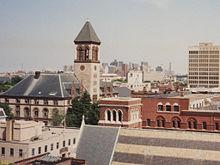
Cambridge has a city government led by a Mayor and nine-member City Council. There is also a six-member School Committee which functions alongside the Superintendent of public schools. The councilors and school committee members are elected every two years using the single transferable vote (STV) system. Since the disbanding of the New York City Community School Boards in 2002, Cambridge's Council is now unusual in being the only governing body in the United States to still use STV. Once a laborious process that took several days to complete by hand, ballot sorting and calculations to determine the outcome of elections are now quickly performed by computer, after the ballots have been optically scanned.
The mayor is elected by the city councilors from amongst themselves, and serves as the chair of City Council meetings. The mayor also sits on the School Committee. However, the Mayor is not the Chief Executive of the City. Rather, the City Manager, who is appointed by the City Council, serves in that capacity.
Under the City's Plan E form of government the city council does not have the power to appoint or remove city officials who are under direction of the city manager. The city council and its individual members are also forbidden from giving orders to any subordinate of the city manager.
Robert W. Healy is the City Manager; he has served in the position since 1981. In recent history, the media has highlighted the salary of the City Manager as being one of the highest in the State of Massachusetts.
The city council consists of:
* = Current Mayor
The city of Cambridge is protected full-time by the 274 professional firefighters of the Cambridge Fire Department. The current Chief of Department is Gerald R. Reardon. The Cambridge Fire Department operates out of eight fire stations, located throughout the city, under the command of two divisions. The CFD also maintains and operates a front-line fire apparatus fleet of eight engines, four ladders, two Non-Transport Paramedic EMS units, a Haz-Mat unit, a Tactical Rescue unit, a Dive Rescue unit, two Marine units, and numerous special, support, and reserve units. John J. Gelinas, Chief of Operations, is in charge of day to day operation of the department. The CFD is rated as a Class 1 fire department by the Insurance Services Office (ISO), and is one of only 32 fire departments so rated, out of 37,000 departments in the United States. The other class 1 departments in New England are in Hartford, Connecticut and Milford, Connecticut. Class 1 signifies the highest level of fire protection according to various criteria. The CFD responds to approximately 15,000 emergency calls annually.
Cambridge is unusual among cities inside Route 128 in having a non-MWRA water supply. City water is obtained from Hobbs Brook (in Lincoln and Waltham), Stony Brook (Waltham and Weston), and Fresh Pond (Cambridge). The city owns over 1200 acres of land in other towns that includes these reservoirs and portions of their watershed. Water is treated at Fresh Pond, then pumped uphill to an elevation of 176 feet (54 m) above sea level at the Payson Park Reservoir (Belmont); From there, the water is redistributed downhill via gravity to individual users in the city.
Cambridge is a county seat of Middlesex County, Massachusetts, along with Lowell. Though the county government was abolished in 1997, the county still exists as a geographical and political region. The employees of Middlesex County courts, jails, registries, and other county agencies now work directly for the state. At present, the county's registrars of Deeds and Probate remain in Cambridge; however, the Superior Court and District Attorney have had their base of operations transferred to Woburn. Third District court has shifted operations to Medford, and the Sheriff's office for the county is still awaiting a near-term relocation.
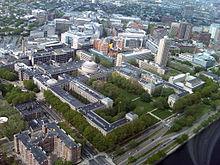
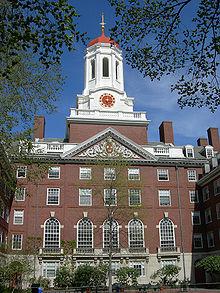
Cambridge is perhaps best known as an academic and intellectual center, owing to its colleges and universities, which include:
At least 129 of the world's total 780 Nobel Prize winners have been, at some point in their careers, affiliated with universities in Cambridge.
The American Academy of Arts and Sciences is also based in Cambridge.
The Cambridge Public School District encompasses 12 elementary schools that follow a variety of different educational systems and philosophies. All but one of the elementary schools extend up to the middle school grades as well. The 12 elementary schools are:
There are three public high schools serving Cambridge students, including the Cambridge Rindge and Latin School. and Community Charter School of Cambridge (www.ccscambridge.org)
In 2003, the CRLS, also known as Rindge, came close to losing its educational accreditation when it was placed on probation by the New England Association of Schools and Colleges. The school has improved under Principal Chris Saheed, graduation rates hover around 98%, and 70% of students gain college admission.
Community Charter School of Cambridge serves 350 students, primarily from Boston and Cambridge, and is a tuition free public charter school with a college preparatory curriculum. All students from the class of 2009 and 2010 gained admission to college.
Outside of the main public schools are public charter schools including: Benjamin Banneker Charter School, which serves students in grades K-6, Community Charter School of Cambridge, which is located in Kendall Square and serves students in grades 7 ae12, and Prospect Hill Academy, a charter school whose upper school is in Central Square, though it is not a part of the Cambridge Public School District.
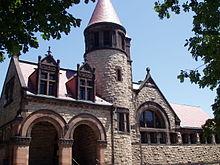
There are also many private schools in the city including:
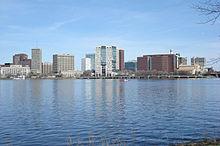
Manufacturing was an important part of the economy in the late 19th and early 20th century, but educational institutions are the city's biggest employers today. Harvard and MIT together employ about 20,000. As a cradle of technological innovation, Cambridge was home to technology firms Analog Devices, Akamai, Bolt, Beranek, and Newman (BBN Technologies) (now part of Raytheon), General Radio (later GenRad), Lotus Development Corporation (now part of IBM), Polaroid, Symbolics, and Thinking Machines.
In 1996, Polaroid, Arthur D. Little, and Lotus were top employers with over 1,000 employees in Cambridge, but faded out a few years later. Health care and biotechnology firms such as Genzyme, Biogen Idec, Millennium Pharmaceuticals, Sanofi, Pfizer and Novartis have significant presences in the city. Though headquartered in Switzerland, Novartis continues to expand its operations in Cambridge. Other major biotech and pharmaceutical firms expanding their presence in Cambridge include GlaxoSmithKline, AstraZeneca, Shire, and Pfizer. Most Biotech firms in Cambridge are located around Kendall Square and East Cambridge, which decades ago were the city's center of manufacturing. A number of biotechnology companies are also located in University Park at MIT, a new development in another former manufacturing area.
None of the high technology firms that once dominated the economy was among the 25 largest employers in 2005, but by 2008 high tech companies Akamai and ITA Software had grown to be among the largest 25 employers. Google, IBM Research, and Microsoft Research maintain offices in Cambridge. In late January 2012 aeless than a year after acquiring Billerica-based analytic database management company, Vertica aeHewlett-Packard announced it would also be opening its first offices in Cambridge. Around this same time, e-commerce giants Staples and Amazon.com said they would be opening research and innovation centers in Kendall Square. Video game developer Harmonix Music Systems is based in Central Square.
The proximity of Cambridge's universities has also made the city a center for nonprofit groups and think tanks, including the National Bureau of Economic Research, the Smithsonian Astrophysical Observatory, the Lincoln Institute of Land Policy, Cultural Survival, and One Laptop per Child.
In September 2011, an initiative by the City of Cambridge called the "Entrepreneur Walk of Fame" was launched. It seeks to highlight individuals who have made contributions to innovation in the global business community.
The top ten employers in the city are:
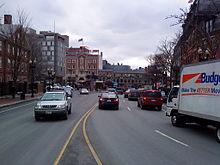
Several major roads lead to Cambridge, including Route 2, Route 16 and the McGrath Highway (Route 28). The Massachusetts Turnpike does not pass through Cambridge, but provides access by an exit in nearby Allston. Both U.S. Route 1 and I-93 (MA) also provide additional access on the eastern end of Cambridge at Leverett Circle in Boston. Route 2A runs the length of the city, chiefly along Massachusetts Avenue. The Charles River forms the southern border of Cambridge and is crossed by 11 bridges connecting Cambridge to Boston, including the Longfellow Bridge and the Harvard Bridge, eight of which are open to motorized road traffic.
Cambridge has an irregular street network because many of the roads date from the colonial era. Contrary to popular belief, the road system did not evolve from longstanding cow-paths. Roads connected various village settlements with each other and nearby towns, and were shaped by geographic features, most notably streams, hills, and swampy areas. Today, the major "squares" are typically connected by long, mostly straight roads, such as Massachusetts Avenue between Harvard Square and Central Square, or Hampshire Street between Kendall Square and Inman Square.
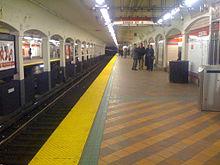
Cambridge is well served by the MBTA, including the Porter Square stop on the regional Commuter Rail, the Lechmere stop on the Green Line, and five stops on the Red Line (Alewife, Porter Square, Harvard Square, Central Square, and Kendall Square/MIT). Alewife Station, the current terminus of the Red Line, has a large multi-story parking garage (at a rate of $7 per day as of 2009[update]). The Harvard Bus Tunnel, under Harvard Square, reduces traffic congestion on the surface, and connects to the Red Line underground. This tunnel was originally opened for streetcars in 1912, and served trackless trolleys and buses as the routes were converted. The tunnel was partially reconfigured when the Red Line was extended to Alewife in the early 1980s.
Cambridge has several bike paths, including one along the Charles River, and the Linear Park connecting the Minuteman Bikeway at Alewife with the Somerville Community Path. Bike parking is common and there are bike lanes on many streets, although concerns have been expressed regarding the suitability of many of the lanes. On several central MIT streets, bike lanes transfer onto the sidewalk. Cambridge bans cycling on certain sections of sidewalk where pedestrian traffic is heavy.
While Bicycling Magazine has rated Boston as one of the worst cities in the nation for bicycling (In their words, for "lousy roads, scarce and unconnected bike lanes and bike-friendly gestures from City Hall that go nowhere aesuch as hiring a bike coordinator in 2001, only to cut the position two years later"), it has listed Cambridge as an honorable mention as one of the best and was called by the magazine "Boston's Great Hope." Cambridge has an active, official bicycle committee.

Walking is a popular activity in Cambridge. Per year 2000 data, of the communities in the U.S. with more than 100,000 residents, Cambridge has the highest percentage of commuters who walk to work. Cambridge receives a "Walk Score" of 100 out of 100 possible points. Cambridge's major historic squares have been recently changed into a modern walking landscape, which has sparked a traffic calming program based on the needs of pedestrians rather than of motorists.
The Boston intercity bus and train stations at South Station, Boston, and Logan International Airport in East Boston, are accessible by subway. The Fitchburg Line rail service from Porter Square connects to some western suburbs. Since October 2010, there has also been intercity bus service between Alewife Station (Cambridge) and New York City.
Cambridge is served by several weekly newspapers. The most prominent is the Cambridge Chronicle, which is also the oldest surviving weekly paper in the United States.
Cambridge is home to the following commercially licensed and student-run radio stations:
Cambridge Community Television (CCTV) has served the Cambridge community since its inception in 1988. CCTV operates Cambridge's public access television facility and programs three television channels, 8, 9, and 96 on the Cambridge cable system (Comcast).
As of 2011, a growing number of social media efforts provide means for participatory engagement with the locality of Cambridge, such as Localocracy and Foursquare.
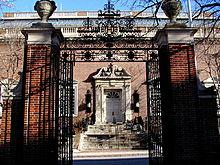
Cambridge has a large and varied collection of permanent public art, both on city property (managed by the Cambridge Arts Council), and on the campuses of Harvard and MIT. Temporary public artworks are displayed as part of the annual Cambridge River Festival on the banks of the Charles River, during winter celebrations in Harvard and Central Squares, and at university campus sites. Experimental forms of public artistic and cultural expression include the Central Square World's Fair, the Somerville-based annual Honk! Festival, and If This House Could Talk, a neighborhood art and history event.[original research?] An active tradition of street musicians and other performers in Harvard Square entertains an audience of tourists and local residents during the warmer months of the year. The performances are coordinated through a public process that has been developed collaboratively by the performers, city administrators, private organizations and business groups.
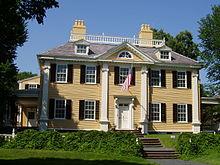
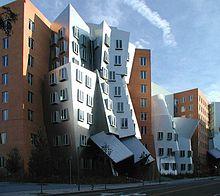
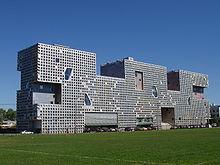
Despite intensive urbanization during the late 19th century and 20th century, Cambridge has preserved an unusual number of historic buildings, including some dating to the 17th century. The city also contains an abundance of innovative contemporary architecture, largely built by Harvard and MIT.
The city has an active music scene from classical performances to the latest popular bands.
Cambridge has 8 active, official sister cities, and an unofficial relationship with Cambridge, England:
Ten other official sister city relationships are inactive: Dublin, Ireland; Ischia, Catania, and Florence, Italy; KrakR³w, Poland; Santo Domingo Oeste, Dominican Republic; Southwark, London, England; Yuseong, Daejeon, Korea; and Haidian, Beijing, China.
There has also been an unofficial relationship with:
Word Count: 5788






